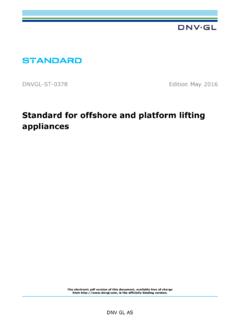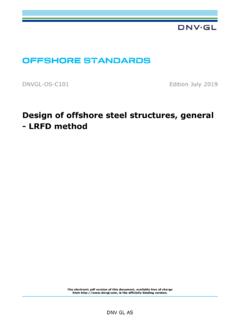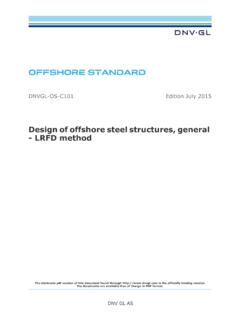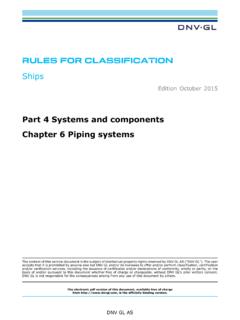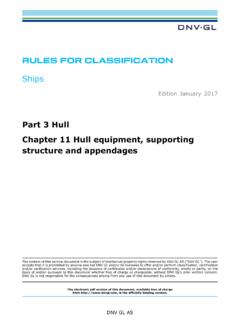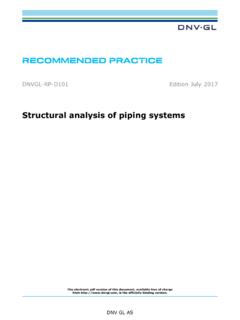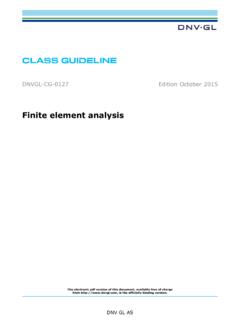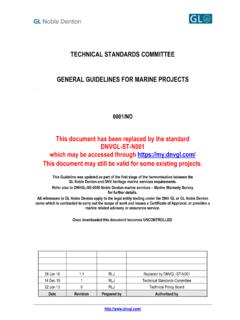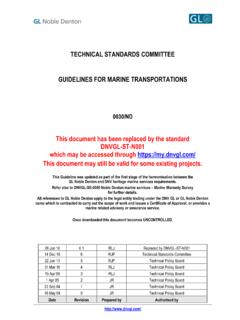Transcription of DNVGL-ST-0377 Standard for shipboard lifting appliances
1 The electronic pdf version of this document, available free of chargefrom , is the officially binding GL ASSTANDARDDNVGL-ST-0377 Edition May 2016 Standard for shipboard lifting appliancesFOREWORDDNV GL standards contain requirements, principles and acceptance criteria for objects, personnel,organisations and/or operations. dnv gl AS May 2016 Any comments may be sent by e-mail to service document has been prepared based on available knowledge, technology and/or information at the time of issuance of thisdocument. The use of this document by others than dnv gl is at the user's sole risk. dnv gl does not accept any liability or responsibilityfor loss or damages resulting from any use of this - currentStandard DNVGL-ST-0377 . Edition May 2016 Page 3 Standard for shipboard lifting appliancesDNV GL ASCHANGES - CURRENTThis is a new DNVGL-ST-0377 . Edition May 2016 Page 4 Standard for shipboard lifting appliancesDNV GL ASCONTENTSC hanges - 1 General Certification Type of 2 Documentation and Documentation to be 23 Section 3 Selection of Manufacture and Materials for welded Materials for hydraulic Steel Bolts and 41 Section 4 Design and calculation Design Calculation Proof of structural Proof of safety against Proof of fatigue Proof of suitability for Special structural 81 Section 5 Cranes and supporting Crane Design 102 ContentsStandard DNVGL-ST-0377 .
2 Edition May 2016 Page 5 Standard for shipboard lifting appliancesDNV GL Hoist load Load combinations and partial safety Requirements for design and 120 Section 6 Special lifting appliances and means of Rope and chain Ramps and car lifting appliances for research Industrial cargo-handling Means of conveying 7 Loose gear and interchangeable Loose Interchangeable Marking of loose gear and interchangeable Wear, damage, 8 Ropes and rope Wire Fibre Rope-end Tests and 9 Mechanical Design criteria and operational Power Slewing gears and slew Hydraulic Protective measures and safety Examination of drawings and supervision of 10 Electrical DNVGL-ST-0377 . Edition May 2016 Page 6 Standard for shipboard lifting appliancesDNV GL Design criteria and operational Drives and Cables and Protective measures and safety Examination of drawings and supervision of 11 Construction of steel Requirements for Design Types of Workmanship and testing of weld Examination of drawings and supervision of 12 Technical and operational safety Design Safety Passive protective Stowage and lashing Operational 13 Testing and examination of shipboard lifting Supervision of Initial test and Periodic tests and Extraordinary tests and Wear, damage, lifting appliance A Calculation of dynamic forces due to motions of the Dynamic forces generated by ships and similar floating Dynamic forces due to pontoons or DNVGL-ST-0377 .
3 Edition May 2016 Page 7 Standard for shipboard lifting appliancesDNV GL ASAppendix B Detail classification for fatigue strength analysis (FAT classes).. 261 Appendix C Wind loads, form and sheltering Form coefficients Sheltering coefficients ..275 Appendix D Rigging DNVGL-ST-0377 . Edition May 2016 Page 8 Standard for shipboard lifting appliancesDNV GL ASSECTION 1 GENERAL This Standard provides requirements for certification and verification of lifting appliances intendedfor load handling within and outside vessel while in the harbour or in sheltered waters and within the vesselwhile at note:For lifting appliances intended for load handling outside vessel while at open sea, and load handling onboard offshore units/installations, see dnvgl ST 0378 Standard for Offshore and Platform lifting This Standard covers the design, materials, fabrication, installation, testing and commissioning ofshipboard lifting appliances and industrial lifting categorization of lifting appliances is based on installation and intended function for the lifting appliance:a) shipboard lifting appliances .
4 lifting appliances on board ships intended for load handling within and outside ships while in theharbour and within ships while at ) Industrial lifting appliances : lifting appliances onshore and offshore, not covered by a) and dnvgl ST note:The main purpose of the lifting appliance will define the category of the lifting appliance and relevant applicable Each lifting appliance has its separate intended functions. Examples of intended functions are, butnot limited to: loading and discharging of ships handling of provision, store and spare parts, cargo hoses, gangways and ammunition handling of Suez Canal boats and search lights conveyance of persons/personnel handling of ramps and moveable cargo decks Requirements presented herein are minimum requirements to be satisfied, although subject toacceptance by the Society, other minimum requirements may be agreed based on new technologyavailable at the time of application for The requirements of this Standard may be supplemented with additional requirements whereinstallation of specific design or assessment shows that standards that provides equivalent or higher level ofintegrity and safety are more The Standard consists of a three level hierarchy of documents: and provides principles and procedures of the Society's classification, certification, verificationand consultancy DNVGL-ST-0377 .
5 Edition May 2016 Page 9 Standard for shipboard lifting appliancesDNV GL AS through provides technical provisions and acceptance criteria as well as the technical basisfor the services stated in the first two sections. Appendices, provides proven technology and sound engineering practice as well as guidance for the higherlevel documents mentioned in this This Standard distinguishes between: information and description of services , these two subjects are separated, and the Standard is divided into three parts: - : General information, application, definitions and references. Description of applicableservices and relations to rules and regulation from institutions other than the Society. - : Requirements and technical provisions. This Standard shall be applied for certification of shipboard lifting appliances for vessels with classnotation Crane. This Standard may also be applied as voluntary basis for verification and certification oflifting appliances that are not classed with the note:The Standard may also be applied to industrial The requirements presented herein should be applied consequently from concept design through thefinal construction, including major Specifications of the services provided by this Standard are given in [ ] and [ ].
6 The Standard does not apply to launching appliances for LSA, launching gear for diving equipmentand ROVs, structural parts of ramps and car decks, dredging appliances , which are no loading gear, personnellifts (elevators), jacks, overhead drilling equipment, fork lifts, portable hoisting gear Personnel lifting with cranes otherwise designed for lifting of loads/cargo may be covered Without prejudice to [ ], deviations from the requirements given in this Standard may onlybe substituted where shown to provide an equivalent or higher level of integrity or safer than under At the Society s discretion equivalent solutions and exemptions from the requirements given in thisstandard may be In case of conflict between requirements given in this Standard and a reference document, therequirements given in this Standard shall Where reference is made to codes other than the Society's documents, the valid revision shall betaken as the revision which was current at the date of issue of this Standard , unless otherwise DNVGL-ST-0377 .
7 Edition May 2016 Page 10 Standard for shipboard lifting appliancesDNV GL Relation to the Society's other For lifting appliances covered by the class notation, Crane, see RU SHIP installed cranes Definitions, abbreviations, symbols and AccessoriesLoad-bearing, not rigidly attached, interchangeable parts which may be integral components of liftingappliances and loose gear as well as employed individually, such as: Hooks, blocks, shackles, swivels, rings,chains, claws, clamps, pliers, load fastening ropes (slings/strops), lifting straps, Active cable tensioning system (ACT)System keeping the tension of the hoisting wire to a given set point note:A supply of external energy is Active heave compensation system (AHC)System that maintains the position of the load to a given set point note:A supply of external energy is Actual hook loadThe static weight of the load attached to the hook; includes the useful load lifted plus any loose gear used,such as slings, lifting beams, Additional class notationsCode used by the classification societies to confirm that a vessel possesses certain systems, equipment orfeatures covered by the classification.
8 (Examples are HELDK, Crane, E0 and F-AMC).Guidance note:E0 means that the vessel complies with requirements for having unattended machinery space and F-AMC means that the vesselcomplies with requirements for additional fire protection, in this case both for accommodation, machinery space and cargo Ship type notationCode used by the classification societies to define a type of vessel related to its most typical service. (Tankerfor oil, Passenger ship and Crane vessel are typical examples). Automatic overload protection system (AOPS)A system that automatically safeguards and protects the crane against overload and over-moment duringoperation by allowing the hook to be pulled away from the crane in order to avoid significant Certificate of conformityA document attesting that a product or service is in conformity with specific standards or technicalspecifications. (ISO Certification - Principles and practice. , 1980). Issued by manufacturer or Competent person/bodyPerson or body possessing knowledge and experience required for performing thorough examination and testof lifting appliances and loose gear, and who is acceptable to the competent DNVGL-ST-0377 .
9 Edition May 2016 Page 11 Standard for shipboard lifting appliancesDNV GL Crane stiffnessCoefficient defined as the weight attached to the hook necessary to obtain a unit deflection at the hook CustomerAgreement (contract) holder with the Society. Signifies the party who has requested the Society s Dead loadsDead loads are the weights of all the fixed and mobile components of lifting appliances and loose gearpermanently present during the purpose of marking, the dead loads of loose gear are designated as weight by the ILO. The unit isspecified in tons (t) or kilograms (kg). DesignerSignifies a party who creates documentation submitted to the Society for approval or Design approvalVerifying that a design, represented by a drawing or set of drawings, is found to comply with all requirementgiven in a specified Society Standard or Society note:In the Society's business procedures design approvals are valid for one order only. One order, however, may include a specifiednumber of units for specified Design approval letterWritten confirmation of a design Design assessment for type approvalExamination and acceptance of a design for type approval.
10 The type approval will be assigned first after aprototype test also has been successfully carried Design dynamic factorThe dynamic factor applied to the working load for a specific SWLG uidance note:For an offshore crane the design dynamic factor is normally referred to the still water condition for determining the SWL at still design dynamic factor may, however, be defined also to refer to a specified significant wave Design verification report (DVR)Formalized report confirming the result of a completed design verification Dynamic factorA variable factor representing the dynamic effects that the working load is exposed to. Also named Dynamic loadThe working load when subjected to (multiplied with) a dynamic Dynamic load chartDiagram or table showing rated capacity depending on sea state and on radius or boom Engineered liftSafe lift planned by qualified engineers with basis in thorough information with respect to crane capacity,crane functions and performance, rigging, crane support as well as weather and sea DNVGL-ST-0377 .
